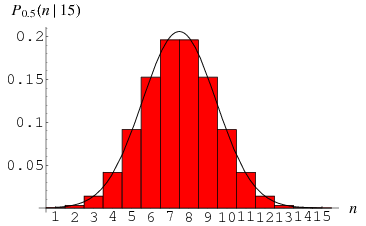Normal Distribution
Normal Distribution Definition
The normal distributions are a very important class of statistical distributions. All normal distributions are symmetric and have bell-shaped density curves with a single peak. A function that represents the distribution of many random variables as a symmetrical bell-shaped graph.
A normal distribution in a variate |
(1)
|
de Moivre developed the normal distribution as an approximation to the binomial distribution, and it was subsequently used by Laplace in 1783 to study measurement errors and by Gauss in 1809 in the analysis of astronomical data (Havil 2003, p. 157).
The normal distribution is implemented in Mathematica as NormalDistribution[mu, sigma].
The so-called "standard normal distribution" is given by taking
|
(2)
|
The normal distribution function
|
(3)
| |||
|
(4)
|
Normal Distribution Curve

The normal distribution is the limiting case of a discrete binomial distribution
|
(5)
| |||
|
(6)
|
The distribution
|
(7)
|
|
(8)
| |||
|
(9)
| |||
|
(10)
|
Normal distributions have many convenient properties, so random variates with unknown distributions are often assumed to be normal, especially in physics and astronomy. Although this can be a dangerous assumption, it is often a good approximation due to a surprising result known as the central limit theorem. This theorem states that the mean of any set of variates with any distribution having a finite mean and variance tends to the normal distribution. Many common attributes such as test scores, height, etc., follow roughly normal distributions, with few members at the high and low ends and many in the middle.
Because they occur so frequently, there is an unfortunate tendency to invoke normal distributions in situations where they may not be applicable. As Lippmann stated, "Everybody believes in the exponential law of errors: the experimenters, because they think it can be proved by mathematics; and the mathematicians, because they believe it has been established by observation" (Whittaker and Robinson 1967, p. 179).
Among the amazing properties of the normal distribution are that the normal sum distribution and normal difference distribution obtained by respectively adding and subtracting variates
Using the k-statistic formalism, the unbiased estimator for the variance of a normal distribution is given by
|
(11)
|
|
(12)
|






0 comments:
Post a Comment